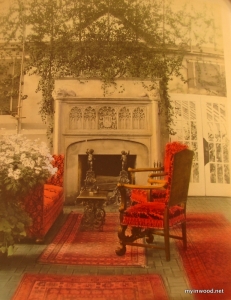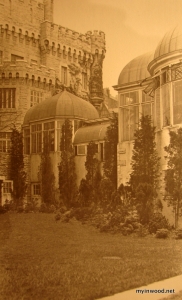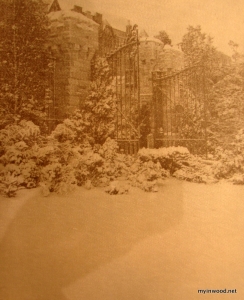In the late 1800’s Northern Manhattan was still very much a wilderness of farmland dotted with occasional country inns and taverns, but that rural tranquility would end with the industrial age. The clean air and remoteness of the area soon attracted newly minted millionaires who created splendid monuments to their own wealth. For a brief shining moment Inwood and parts of Washington Heights became a turn of the century equivalent to the Hamptons or Martha’s Vineyard.
Enter real estate tycoon Dr. Charles V. Paterno who, in 1905, began construction on a four-story castle designed by John C. Watson for the then outrageous sum of $500,000. The castle, which sat on over seven acres of property, was located on the site of today’s Castle Village Apartments.

The son of immigrants, Paterno’s family sailed from Castelmezzano, Italy in the 1880’s after a devastating earthquake left the family real estate business in shambles. In short time, the Paterno’s had established themselves as players on the New York real estate scene, developing luxury apartment buildings up and down the Upper West Side of Manhattan.
A physician by trade, Paterno left medicine upon his father’s death and assumed the helm of the family business.
Why he built the home is anyone’s guess. Perhaps it reminded him of a structure from his Italian homeland.
The beautiful white stone, turrets, greenhouse and pergola set Paterno’s castle apart from his neighbors, with the exception of nearby Libby Castle, in terms of design.
Paterno spared no expense in designing his dream home. Among the mansion’s many features were, a swimming pool surrounded by birdcages, a mushroom cellar and, measuring twenty by eighty feet, perhaps the largest master bedroom the neighborhood has ever seen.
Below photos from a brag book commissioned by Paterno in 1930 titled “The Castle.”
As old age set in, Paterno found himself spending less time in the castle of his youth. Settling in Greenwich, Connecticut, Paterno ordered his castle demolished in 1938 to make room for Castle Village. (Amazing newsreel footage of demolition)

…But while Paterno’s Castle is gone, its memories live on.
In the 1930’s, Inwood resident Florence Schwartz, the daughter of Russian immigrants, had unique access to Paterno’s estate. The father of one of her childhood friends was the heating engineer for the sprawling complex. In her own words, Florence takes us onto the grounds when Charles Parteno was still king of his castle and she was just a young girl.
“I used to go to the estate in the 1930’s to visit a friend who went to PS 187. That was the elementary school.
They had a garage and there were probably four or five Rolls Royce’s. That’s the only car they drove. At that age I thought that must have been pretty nifty.

My friend’s father worked on the estate. I never paid any attention. We were just going to pick up Eleanor. We didn’t go though any front gates. We went down where; I presume everyone lived—because all the chauffeurs lived on top of the garage that I remember. I don’t remember where the gardeners lived. I was a kid—who pays attention to that?
As I was walking onto the grounds there were paved walkways and my friend lived in a very nice little house, it wasn’t a bungalow, it was a little house. I don’t know if that was where he took care of the heating or not. When you’re ten or eleven you don’t think about that.

I never met Dr. Paterno. The only thing I ever heard come from the castle was when one of his children was married and they did it there. Rosa Ponselle, the opera star, sang for them and everyone knew about that.
Did you ever go into the swimming pool? No, no one ever went into the swimming pool. They just showed it to me. Eleanor’s father showed it to us.
Nobody in the neighborhood seemed to notice the castle because they had just built some new apartment buildings with elevators. That was something new—elevators.
I think people got more excited when the George Washington Bridge was being built. That was pretty exciting.
You didn’t have telephones, but they had a switchboard downstairs in the building where I lived. That seemed pretty good.”
Author’s note: Intimate portraits of the neighborhood like this wouldn’t exist without the active participation of the community. If you, or someone close to you, has old photos or memories you would like to share, I encourage you to contact me. Again, a special thanks to Florence for sharing her uptown memories.























Truly amazing articles. Each one is more and more interesting. Will there be more presentations at the Indian Road cafe? The last one was too crowded.
Thanks for the vote of confidence. We do the presentations the first Tuesday of every month at 7:00pm. They do seem to get more and more crowded. Perhaps we’ll have to add a second night down the road. Thanks again. Cole
Very interesting, as usual. The first-person memoirs are neat. The picture w/Castle Village 1939…was it taken from a boat? It looks too close to be taken from NJ.
Betty Lee
Thanks for sharing this amazing piece of NY history. Very well done. Hats off to you!
My Grandfather help build the Paterno Castle. He came from Castelmezzano Italy. He knew
Mr Paterno. As a child my father his son would tell me stories about this great castle. I always
wanted to see pictures of this castle. My grandfather’s cousin was a driver for the Paterno family.
He lived on the grounds of this castle. It is a shame that it is now lost.
Hello, I am a direct descendant of Dr. Charles Vincent Paterno. My mother was married to Robert S. Paterno. My Grandfather was Charles V. Paterno or as know by the family as Canio Paterno. My Great Grandfather is Servario Paterno who is the older brother of Dr. Charles Vincent Paterno. When was about 6 years old my mother and father divorced. I was adopted by my stepfather thus the name change. I have always considered my self a Paterno and if old enough would not have changed my last name but I had no say. My step mother has done a extensive genealogy study on my family and has published a book about the Paterno’s from 1850 – 2004. In it are some great pictures of inside the castle. I would love to find a postcard of the castle. Your web is great if you have more information I would love to hear about it. I have been to New York and have personally seen some of the buildings my great uncles built. I have also been inside the Castle Village and have seen the plaque honoring my great uncle. thanks for listening.
My grandfather, Eugene Russel, worked for the Paterno family. He was a painter/contractor back in the 1920’s to 1940’s. I’d love to find the book written by your stepmother regarding the castle. My grandfather spoke often of the home on Riverside Drive. Thank you very much.
I always wanted to know who built those “fort looking” walls on the West Side highway. Now I know it was an estate. Thank you for posting this. Very interesting.
My maternal grandfather, Carlo Paterno, was the son of Dr. Charles Paterno who built the castle. I have limited information of the family and castle if anyone has further questions. I would love to be of service to help keep the history alive.
I grew up in Windmill Farm which was a farm built by Dr. Paterno consisting of approximately 360 acres. I know of two scrap books filled with lovely pictures of both the outside and grounds of the castle, as well as many inside pictures. I grew up hearing from family members that the castle was torn down because the newly constructed George Washington bridge ruined the view.
I just read your comments on myinwood.net. My grandfather was the painting/contractor for Dr. Paterno from the 30’s through 40’s. I have been searching for photos of the interior or the castle since my grandfather was given pieces of furniture from the castle by Dr. Paterno. I would love seeing any that you have. Thank you very much.
I would be very interested in talking to Ms. Schwartz. My grandfather was the grounds superintendent for Dr. Paterno and my aunt’s name is Eleanor Taglieri. I believe she is speaking of my Aunt Eleanor in is this article. My father was born in the castle library in 1923. Would love more information if anyone as something to share.
[…] an Italian immigrant who built a real estate fortune in New York City. Barely 40 years after Paterno had it built to the design of John C. Watson for $500,000, the castle was torn down in 1938 to make way for the repeating towers of Castle […]
[…] an Italian immigrant who built a real estate fortune in New York City. Barely 40 years after Paterno had it built to the design of John C. Watson for $500,000, the castle was torn down in 1938 to make way for the repeating towers of Castle […]
[…] an Italian immigrant who built a real estate fortune in New York City. Barely 40 years after Paterno had it built to the design of John C. Watson for $500,000, the castle was torn down in 1938 to make way for the repeating towers of Castle […]
[…] Paterno’s Castle [My Inwood] […]
[…] After a short span as a bucolic path, the Greenway exits the park through a tunnel and ends up (almost) at grade with the Henry Hudson Parkway. This section of the path does not provide much room for cyclists and pedestrians to share. One of the noteworthy sites along this expanse of the Castle Village’s retaining wall which is left over from Dr. Charles V. Paterno’s, Paterno Castle. […]
[…] After a short span as a bucolic path, the Greenway exits the park through a tunnel and ends up (almost) at grade with the Henry Hudson Parkway. This section of the path does not provide much room for cyclists and pedestrians to share. One of the noteworthy sites along this expanse of the Castle Village’s retaining wall which is left over from Dr. Charles V. Paterno’s, Paterno Castle. […]
When I was a child, my parents,my brother and I lived in Hudson View Gardens . We later moved to Castle Village(120 Northern Ave.) which became Cabrini Blvd. when Mother Cabrini was declared the first American Citizen Saint in 1946. Senator Jacob Javits also resided there and belonged to the same American Legion Post as my father, Roger L. Sullivan. The grounds were lovely and had a wading pool and sandbox for children.There was great winter sledding between 140 and 160 and to roller skate from 200 Cabrini Blvd.down to 181st St. was a lark.
Sr. Mary Louise Sullivan, MSC, Ph.D.,Past President, Cabrini College, Radnor,PA.
My dad managed the Bank of Manhattan branch on 181st St. and knew Dr. Paterno as a customer and a friendly person despite his wealth. When we moved to the Heights in 1938, the castle was still on Northern Ave., but when we moved across the street from the castle a year later, we were in 125 Cabrini Blvd. and the castle was already almost completely torn down.
My parents looked at a three-bedroom model apartment and loved the view, but thought the rent was too high ($100/month) and the rooms were too small. So we moved to another new building, 17 Chittenden, into an apartment with a terrace. We’d watch wartime convoys forming up on the Hudson.
Castle Village’s northernmost building, No. 200, had a garage underneath. I’m not sure if they pumped gas there, but they did have air pumps and we guys would regularly take our two-wheelers down to inflate tires. Just as regularly, we’d get chased and even more regularly, we’d return until we’d succeed.
It’s true that Paterno earlier had developed Hudson View Gardens and I understand he made two promises to his buyers there. First, that their river view would never be blocked, since only his four-storey castle stood between them and the Hudson. And second, that they need have no concern about “undesirables” among their neighbors, because he would sell to neither Jews nor Negroes (to use the term of those days). So Hudson View Gardens became a white Christian enclave in a predominantly Jewish neighborhood. I suspect that Paterno considered himself neither an anti-Semite nor a racist. This was just business. And I never heard of any discrimination in rentals at Castle Village. But a lot of the area chuckled when he broke his promise to the Hudson View Gardeners by blocking their view with his 12-storey Castle Village.
I lived in Castle Village from 1946, when I was born till about 1968. What a great place to live in. We use to play in the “Pit”, which was where the entrance to the garage was, which was also where the castle was. All the kids use to go sledding between 140 and 160, which was great. I couldn’t ask for a better place to live as a kid.
I’m just reading some of the other postings and I must add my two cents. My father loved Jacob Javits, in fact my father looked a lot like him, and Javits always came to our synagogue, the Temple of the Covenant on the Holidays. I am 99% sure that Javits never lived in 120, because if he had my father would have told me, since we lived there. Also, Hudson View Gardens was definitely antisemitic and most probably anti- black as well. As a kid being Jewish myself and living in a Jewish neighborhood everyone would talk about Hudson View and the fact that it discriminated against Jews.
Spent a few years working on projects for Castle Village in the early 2000’s. In doing so I found old plans for the telephone wiring within the castle. Hand drawn prints from 1905 or so. Very detailed layout of wire pathways and phone placement. Imagine a hand drawn document that sat in a folder for 100 years untouched. I also found blueprints of the new Castle Village as well as a brochure used to sell/rent space in the new buildings. I intended to share these with the property owner but I believe he was killed in a plane crash somewhere around 2003.
I’d love to connect with you Mike. My great grandfather Dr. Paterno built Castle Village and I’d love to see the old plans that you have.
My Great Uncle was Greville Rickard, the architect for the Paterno estate on Round Hill, Greenwich CT. I knew of this project through the Library of Congress and I, being a carpenter, was amazed at the scale of this home being built in 1939. I’ve worked on many homes in the Greenwich area but never on one designed by my uncle. He designed several homes in Greenwich and the tri-state area and beyond. I’ve inherited all the saved material, drawings, scrapbooks, magazine and news paper articles from his lifetime of work. I would welcome any further information about his work and greatly appreciate any opportunity to view any of his remaining projects. I would also share any info that I have.
Hello Stephen, My great grandfather was Dr. Charles V. Paterno. I’d love to connect with you regarding his home Round Hill in Greenwich that your great uncle designed.